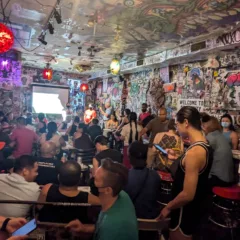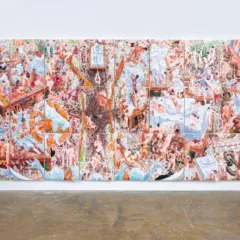“To make honey, young bee need young flower, not old prune,” says Mr. Miyagi, the Yoda-like master in the 1984 movie “The Karate Kid.” More than 25 years on, the idea of the “inscrutable Asian” is mostly swept aside by a sushi-loving West. And now, a local art exhibit uses the one-time insult to mock it. “Inscrutable,” at University of Delaware at Crane Arts (UD Crane), a two-venue show of ethnic artists’ works at UD Crane and Asian Arts Initiative, proves that differences still exist yet nothing is inscrutable. My review covers the UD Crane portion of the show. See Kathleen’s post on the Asian Arts Initiative show immediately below this one.
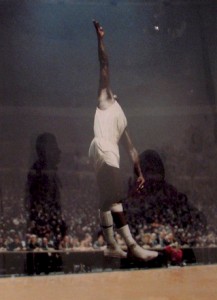
Not all the works use stereotypical Asian motifs but all are about non-Western cultures rubbing up against the West. Some works caricature Western stereotypes and some portray ethnic culture with pride. There’s some anger in the mix. Paul Pfeiffer’s color photo deconstructs Western culture from the point of view of the outsider. “Four Horsemen of the Apocalypse, (2003),” a photo of Michael Jordan mid jump-shot, reminds us how we exoticize difference in sports players yet demonize it outside the arena. Pfeiffer, a New York artist and the biggest name in the show (featured in PBS’s Art 21 series; Whitney Biennial 2000 and many more accolades), is Filippino-born and renowned for his alterations of sports videos to deal with issues of race, beauty and heroism.
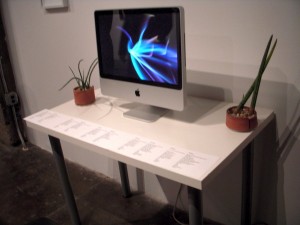
In a show about “us” and “them” local artist and 2009 Fleisher Challenge winner Yvonne Lung’s interactive Internet project “When in Rome” makes difference real. Unfortunately, the imaginative piece wasn’t working when I visited but the idea reverberated loud and clear. “When in Rome” provides a small table with a computer, a chair, and a screen for privacy. The instructions are to sit and have a Skype conversation with a designated stranger on the other end of the connection. The only restriction is that you can’t speak English. Say what? Script suggestions for your talk are laid out on the table with phonetic spellings of simple greetings and phrases in Chinese, German, Dutch, Filipino, and Swahili. “How are you?” “My name is,” and my favorite, “Whatever” (“Ano kailanman,” in Filipino, fyi) are a couple choices. The piece turns the viewer into someone — like a worker in an outsourced call center – who grapples with questions and answers in her non-native tongue. It’s an uncomfortable position to be in. While the piece mimics a sensitivity-training exercise it feels right, and right for this show.
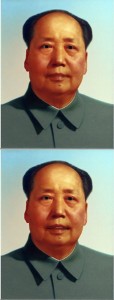
The 13-artist exhibit is spread through UD Crane’s first floor and basement spaces. Downstairs, Jinming Dong’s 16-minute animated video “I Want to Talk: Mao (1956)” mesmerizes. The piece shows Chairman Mao in a Socialist Realist poster animated with a moving mouth and eyes. The animation turns the Supreme Leader into a visual joke out of Monty Python–it’s funny. The audio for the piece is Mao’s 1956 speech to the Association of Music Workers – in English translation, very uninflected and monotonal. Chinese-born Dong’s message is far from clear. Is the University of Delaware MFA candidate mocking Mao or honoring him implying his message lives on in 2011, even in the West? Maybe it’s both. Inscrutable or not, the ambiguous nature of a young Chinese native’s relationship with Mao is worth thinking about.
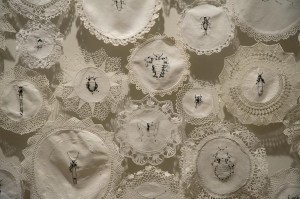
Another ambiguous piece is Lynne Yamamoto’s “Insect Immigrants, after Zimmerman (1948),” an aggressive installation that’s part beautiful, part ugly and conflicted at its core. A group of faded and discolored white cloth doilies sprawls across the wall, each one embroidered, in black, with the image of an invasive insect species found in Hawaii (by entomologist Elwood Zimmerman in 1948). The Victorian-esque found doilies impart a shabby atmosphere and we’re not talking shabby chic. The insects, blown up larger than life, are grotesques. The invaders and the invaded are equal parts pathetic and off-putting. This metaphorical piece about the clash of East and West is not a pretty picture. It’s honest, though.
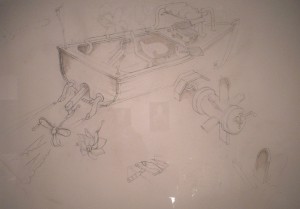
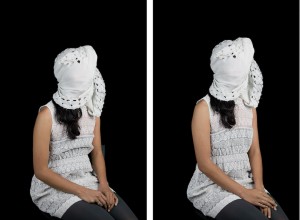
Other standouts in this good show include Rene Marquez’ two-channel video about the Filipino blessing of the animals; Hiro Sakaguchi’s drawing of a boat with a Hibachi-grill motor; and Jennifer Jones-O’Neil’s portrait photos with masked faces. “Inscrutable” is a thoughtful update on difference and very worth your time.
Read this article at Philadelphia Weekly. More photos at flickr.
”Inscrutable,” through Feb. 4. UD at Crane gallery, 1400 N. American St. Closing reception, Feb. 4, 5:30-7:30pm FREE at Asian Arts Initiative, 1219 Vine St.


